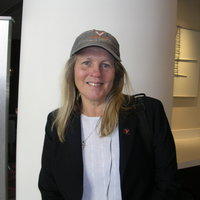If Bhupesh Prusty wins a Nobel Prize for proving HHV-6 is the cause of Chronic Fatigue Syndrome, will he share it with Gallo or Beldekas?
John Beldekas
(Photo by Jane Teas)
"In August, 1986, John Beldekas was invited to go to the NCI and present his findings on the link between ASFV [African Swine Fever virus] and AIDS, which he did. Beldekas gave samples of all his lab work to Gallo. Later, the government asked Beldekas to turn over all his reagents and lab work to the government, which he did. Beldekas had found ASFV presence in nine of 21 AIDS patients using two standard procedures. At the meeting, Gallo was reported saying: “we know it is not ASFV.” How could Gallo know this as he hadn’t done any of his own tests to look for ASFV?
Two months later, Gallo published an article in Science (Oct 31, 1986) that he discovered a new possible co-factor in AIDS, a virus he called Human B Cell Lymphotropic Virus which he named HBLV. Like ASFV, HBLV infected B cells and also lived in macrophages. Did Gallo steal Beldekas’s ASF virus he found in AIDS patients and rename it HBLV? Later on, when Gallo found that HBLV could also infect other immune cells, he changed the name of HBLV to HHV-6. Eventually, Gallo identified his HBLV as the variant A strain of HHV-6 and called it a human herpesvirus."
--Mark Konlee
http://www.keephopealive.org/report10.html
To the Editor: Last September, while conducting a preliminary sociomedical study on acquired immune deficiency syndrome in Rwanda, in the eastern part of central Africa, I was surprised to learn that 50 percent of the pig population had died in an African swine fever epidemic that had begun in December 1983. The epidemic spread northward from Burundi to south-central Rwanda near Butare. This is the same area where Dr. Philippe van de Perre of St. Pierre's Hospital in Brussels and his associates found that 27 of 33 female prostitutes had AIDS or AIDS-related complex, what must certainly be the highest proportion of persons with such symptoms in any at-risk sample yet studied. Eighteen percent of samples of adult blood donors and hospital employees in Kigali, the capital city, were seropositive to human immunodeficiency virus antibody last year. This year, the percentage has increased to 24. Human immunodeficiency virus, in Rwanda at least, appears to be the necessary but not sufficient condition to produce AIDS. Perhaps the African swine fever epidemic and the high rate of illness among prostitutes near Butare is just a coincidence. But, with the recent African swine fever scare caused by the discovery of sickly pigs near Belle Glades, Fla., and with the report by Dr. John Beldekas of Boston University and his associates of some evidence of infection by the African swine fever virus in nearly half of a sample of 21 AIDS patients in the United States, epidemiologists and veterinarians might do well to explore the possibility that this virus is a co-factor in AIDS transmission in central Africa and perhaps other regions of the world. DOUGLAS A. FELDMAN New Haven, July 23, 1986 The writer, a medical anthropologist, is a research fellow at Yale University's Human Relations Area Files Inc.
Learn more about African Swine Fever in Chronic Fatigue Syndrome in this book.
The definitive history of the
Chronic Fatigue Syndrome cover-up.
As the publisher and editor-in-chief of a small newspaper in New York, Charles Ortleb was the first journalist to devote a publication to uncovering the truth about Chronic Fatigue Syndrome. He assigned Neenyah Ostrom the duty of following every twist and turn of the Chronic Fatigue Syndrome story. No newspaper in the world did more to warn the world about the virus called HHV-6 which seems to be triggering Chronic Fatigue Syndrome and many other immunological disorders.This provocative book will end the injustice of the silent treatment Neenyah Ostrom's reporting has been getting from the media and The Chronic Fatigue Syndrome community. Ostrom blew the lid off one of the biggest medical secrets of our time: the link between the Chronic Fatigue Syndrome epidemic and AIDS.
Ostrom interviewed most of the major researchers in the field, as well as countless patients and government scientists. She uncovered so many similarities between Chronic Fatigue Syndrome and AIDS that she came to the conclusion that they are part of the same epidemic, and she argued that until their connection is admitted by top government researchers, there is little hope of making real progress in the fight against Chronic Fatigue Syndrome.
Charles Ortleb's book captures all the challenges and excitement of running a small newspaper that was publishing a brilliant journalist who essentially was the Woodward and Bernstein of the Chronic Fatigue Syndrome epidemic. In Rolling Stone, David Black said Ortleb's newspaper deserved a Pulitzer Prize.














